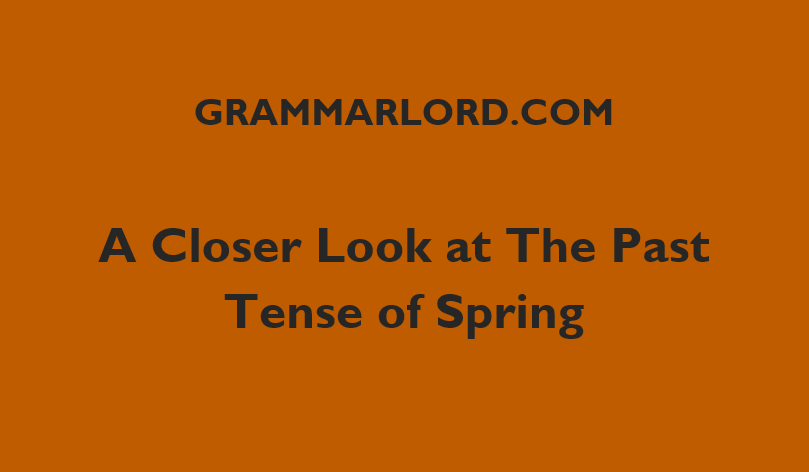Let’s be honest, “spring” as a verb can be a bit of a headache when it comes to the past tense. Is it “sprang,” “sprung,” or did we just accidentally invent these past tenses? As usual, this article must help you understand the right word to use, plus how to use it.
Contents
What You Should Know About Sprang vs. Sprung
Unlike most verbs that follow the predictable “add an -ed” pattern, “spring” is an irregular verb, meaning it has its own unique set of past and past participle forms.
It is noteworthy that “spring” has two perfectly acceptable past tense options: sprang and sprung. The good news is, that both “sprang” and “sprung” are acceptable past-tense forms of “spring.”
READ ALSO: A Closer Look at the Past Tense of Eat”
1. Sprang: This is the classic choice, the one that pops into most minds first. It creates images of sudden jumps like a cat “sprang” onto the counter or a surprise quiz “sprang” on the unsuspecting students. It’s a bit more informal and playful, adding a touch of dynamism to your sentence.
2. Sprung: This option is more formal and common in written English. It often appears in past perfect constructions like
“The lid had sprung open before I could catch it,” or in passive voice sentences like “The trap was sprung by the unsuspecting mouse.”
Granted, the words “sprung” and “sprang” can be confusing because they both form the past tense of the verb “spring,” but they have different uses.
Here Are Some Practical Examples to Help You Distinguish Them
1. Sprang:
Simple past tense: This is the most common use of “sprang.” It refers to a single action that happened in the past, often something sudden or quick.
Examples:
The deer sprang through the forest when it heard the gunshot.
I sprang out of bed when the fire alarm went off.
2. Sprung:
Past participle: This form is used in perfect tenses, with helping verbs like “has,” “have,” or “had.” It can also be used with past participle constructions like “being sprung” or “having sprung.”
Examples:
The trap has sprung, and the animal is now free.
The door was left ajar, having sprung open in the strong wind.
The surprise party was being sprung on her unsuspecting birthday.
READ ALSO: A Closer Look At The Past Tense of Sew
So, which one should you use? Well, the beauty of having two options is the flexibility it gives you. Here’s a handy guide to help you take a side.
- Sprang: Use it for casual situations, lively storytelling, and adding a touch of spontaneity to your writing.
- Sprung: Opt for this in formal writing, when you want to sound more sophisticated, or when using past perfect constructions.
Note: If you’re ever unsure, “sprung” is always a safe bet.
It’s never wrong, even in informal contexts, while using “sprang” in formal writing might raise an eyebrow or two.
Other Things to Know About Spring Beyond The Basics
“Spring” can also be a noun, meaning a season or a source of water. So, if you’re talking about the arrival of warmer weather, you’d say “Spring has sprung!” But if you’re talking about a hidden well, you’d say there’s a “spring” in the forest.
There’s a related verb “springing,” which is the present participle. So, you can say “The deer is springing through the meadow” or “The trap is springing shut.”
And for the truly adventurous: “Spring” can also be used as a noun meaning “elasticity” or “the ability to bounce back.”
So, you could say, “The trampoline has a good spring” or “The economy is showing signs of spring after the recession.” Remember, the key to mastering “spring” is:
- Know your options: Both “sprang” and “sprung” are valid past tense forms.
- Choose wisely: Consider the context and tone of your writing.
READ ALSO: 10 Creative Ways To Say “Thank You For Your Kind Words”
Final Thoughts
Hopefully, this article has taken good care of your misconceptions about the verb “spring” verb. It’s now time to confidently write and speak knowing that you’ve conquered the “spring” challenge.
And hey, if you ever find yourself in a situation where you need to spring into action (literally or figuratively), remember, you’ve got the perfect verb for it.

